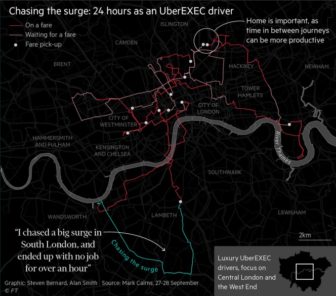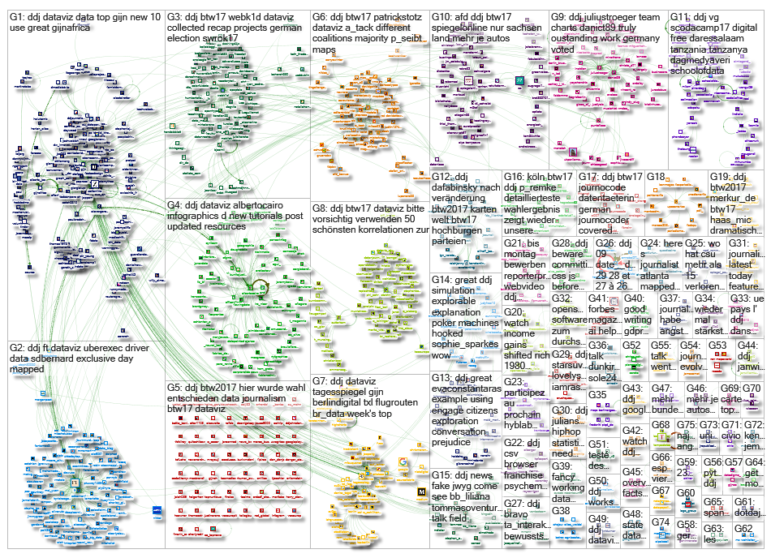 What’s the global data journalism community tweeting about this week? Our NodeXL #ddj mapping from September 25 to October 1 has @FT mapping the route in a day of a London Uber driver, #NICAR18 registration opening up, @Lattif charting Africa’s internet shutdowns using @atlascharts and loads of German election data visualizations by @tagesspiegel, @SPIEGELONLINE, @NZZ, @morgenpost, @zeitonline and more.
What’s the global data journalism community tweeting about this week? Our NodeXL #ddj mapping from September 25 to October 1 has @FT mapping the route in a day of a London Uber driver, #NICAR18 registration opening up, @Lattif charting Africa’s internet shutdowns using @atlascharts and loads of German election data visualizations by @tagesspiegel, @SPIEGELONLINE, @NZZ, @morgenpost, @zeitonline and more.
Mapping Uber London
Financial Times mapped an Uber driver’s day on the road in London. Driver Mark Cairns shared data on his shifts since the ride sharing company was threatened with a ban in the UK capital.
A day in the life of an UberEXEC driver, mapped with exclusive data. @FT https://t.co/SFToZbCjcJ #ddj #dataviz #uberlondon pic.twitter.com/aTgSjV6BHO
— Steven Bernard (@sdbernard) September 29, 2017
2018 NICAR Conference
#NICAR18 registration is now open! Register for this hands-on data journalism training in Chicago from March 8 to 11, 2018.
Registration for @IRE_NICAR 2018 is open! https://t.co/zHbUBHZmwf Best #ddj conference. And we’ll have a @SND-sponsored design track again! pic.twitter.com/yVVDhJ3UMW
— Alberto Cairo (@albertocairo) September 25, 2017
RAWGraphs Tutorial & More
Data visualization expert Alberto Cairo updated the tutorials and resources section on his blog with a RAWGraphs tutorial. Check out the rest of the tutorials on data cleaning, wrangling data, styling charts and more.
Updated Tutorials & Resources section: https://t.co/fyodgKI9t9 #dataviz #BigData #DataScience #MachineLearning pic.twitter.com/Plyvt61VWq
— JL Micó (@jlmico) September 30, 2017
Africa’s Internet Shutdowns
Quartz reporter Abdi Latif Dahir created this graphic, using data from The Collaboration on International ICT Policy for East and Southern Africa to show the extent of the problem of internet shutdowns in Africa.
Get the #data: Internet shutdowns are becoming a mainstay in #Africa https://t.co/42D9iFTrJX #ddj pic.twitter.com/Q84S5HFNGU
— GIJN Africa (@gijnAfrica) October 1, 2017
StoryLab Academy Opportunities
Sign up here to receive alerts about the next StoryLab Academy webinars, newsroom-based workshops and meetups in partnership with local Hacks/Hackers chapters.
Don’t be left behind. Update your digital journalism skills with free courses. Apply here: https://t.co/NdY6UQU7lx #StoryLabAcademy #ddj pic.twitter.com/uvSUS6AeIh
— Code For Africa (@Code4Africa) September 29, 2017
Sparkline Font Tutorial
After the Flood’s AtF Spark font which turns numbers into sparklines has created a buzz among the #ddj community. Paul Bradshaw wrote this tutorial on how to use the font if you’re not already familiar with web fonts and other technicalities of web design.
How to: use the AtF Spark font to create charts with just text https://t.co/Ltpvkx8chK via @wordpressdotcom
— Andrew Matranga 📰 (@andrewmatranga) September 30, 2017
German Election Dataviz Recap
This post lists the colourful scope of projects Moritz Klack and Christopher Möller did in collaboration with the interactive team of the Berliner Morgenpost, as well as stories from other newsrooms that visualize the election results.
From last week: Collection of #BTW17 #dataviz – great insights into results, changes and voter choices via @webk1d https://t.co/8TxGDzWcjb pic.twitter.com/wmJSozDtKn
— DW Innovation (@dw_innovation) October 2, 2017
German Election Deciders
Where was the government most unpopular? Which constituencies have made the AfD and FDP parties so strong? These maps, built by Spiegel Online with MapboxGL, show which regions where the election was decided.
Where the election was decided. Map based #storytelling by @PatrickStotz and @chrTitz #BTW17 https://t.co/HAkMNqsqQr pic.twitter.com/dEhtwTCF21
— Christina Elmer (@ChElm) September 25, 2017
Correlations of German Election
This year’s German election has brought about many surprising results, which sparked a discussion on Twitter as to whether election results can be explained by sociodemographic factors. Here are the 50 strongest correlations of election results and structural features in Germany’s 299 constituencies.
📢https://t.co/OJqdS9woOg ranks Twitter’s most shared #dataviz content. Great stuff like this: https://t.co/3q8Oa1URzu
— Andres Varela 🤓 (@andresvarela) October 2, 2017
German Coalition Scenarios
Spiegel Online evaluates the possibility of coalitions forming in different regions of Germany across 299 constituencies and displays it in six maps.
This is pretty good: re-drawing maps of Germany where a coalition has majority. #Jamaica is basically West Germany. https://t.co/KDMOAs0E9S pic.twitter.com/74RPxDeC3F
— Christian Odendahl (@COdendahl) September 25, 2017
Thanks, once again, to Marc Smith of Connected Action for gathering the links and graphing them.
For a look at Marc Smith’s mapping on #ddj on Twitter, check out this map.

